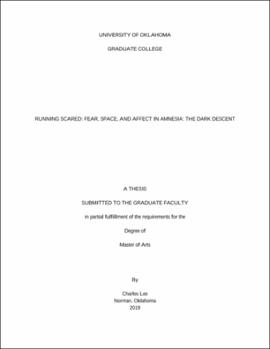| dc.contributor.advisor | Amit, Baishya | |
| dc.contributor.author | Lee, Charles | |
| dc.date.accessioned | 2019-05-10T18:50:36Z | |
| dc.date.available | 2019-05-10T18:50:36Z | |
| dc.date.issued | 2019 | |
| dc.identifier.uri | https://hdl.handle.net/11244/319703 | |
| dc.description.abstract | Most contemporary 3-D video games provide a wealth of visual information to players to help them navigate the in-game virtual space. Maps, compasses, beacons, and other visual guides are often necessary components of gameplay that help players feel confident and powerful within the virtual world. Conversely, the horror video game Amnesia: The Dark Descent uses its claustrophobic configurations of space to reduce the player’s visual and auditory awareness. In this paper, I analyze how these disorienting configurations of space threaten the player’s sense of individual autonomy by restricting their ability to maintain a safe distance from the dangerous monsters within the game. | en_US |
| dc.language | en_US | en_US |
| dc.rights | Attribution-NonCommercial-NoDerivatives 4.0 International | * |
| dc.rights.uri | https://creativecommons.org/licenses/by-nc-nd/4.0/ | * |
| dc.subject | Abstract Space | en_US |
| dc.subject | Amnesia: The Dark Descent | en_US |
| dc.subject | Affect Theory | en_US |
| dc.subject | Horror | en_US |
| dc.title | RUNNING SCARED: FEAR, SPACE, AND AFFECT IN AMNESIA: THE DARK DESCENT | en_US |
| dc.contributor.committeeMember | Zeigler, James | |
| dc.contributor.committeeMember | Kurlinkus, Will | |
| dc.date.manuscript | 2019 | |
| dc.thesis.degree | Master of Arts | en_US |
| ou.group | College of Arts and Sciences::Department of English | en_US |

